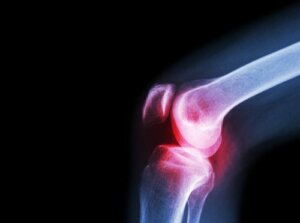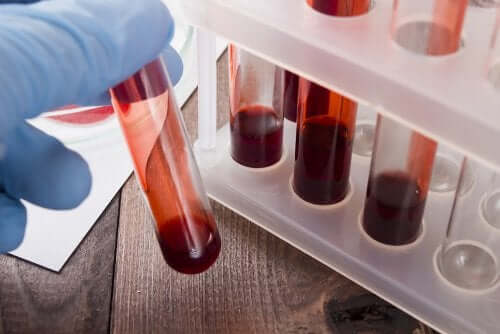Septic Arthritis: The Causes, Symptoms, and Treatment

Septic arthritis is a special type of arthritis also known as infectious arthritis. It consists of the inflammation of a joint due to infection. This infection can be bacterial, viral, or fungal.
Infections can cause arthritis both directly and indirectly. When it occurs directly, the infectious agent is found in the joint. However, in most cases, the infection begins somewhere else in the body and then travels through the bloodstream to the joint.
Septic arthritis can lead to serious consequences in the joint. Discover more about this type of arthritis in the article below.
Causes of septic arthritis
Septic arthritis occurs when pathogenic organisms gain access to a joint. As we mentioned above, in most cases, the infection originates somewhere else in the body and travels through the blood to the joint. However, infections can also develop directly in the joints, as the result of a wound or injury, for example.
Below are a series of situations that increase a person’s risk of experiencing this type of arthritis:
- A bacterial infection in another part of the body.
- Bacteriemia, or the presence of bacteria in the blood.
- Surgery to the join, such as the implantation of a prosthesis.
- Chronic illnesses such as diabetes or rheumatoid arthritis. The same medications used for these illnesses may inhibit the immune system. As a result, these patients are more prone to infections.
- The abuse of intervenous drugs.
- Arthroscopies.
- Trauma.
- Skin conditions. For example, psoriasis and eczema increase a person’s risk of developing septic arthritis.

It’s important to point out that most cases of septic arthritis are caused by bacteria, especially staphylococcus and streptococcus. While it can occur at any age, it occurs most frequently in infants. What’s more, it mainly affects the hip or knee.
You may also want to read: 5 Knee-Strengthening Exercises to Do at Home
Symptoms
The symptoms of septic arthritis vary according to the type of infection. Bacterial infections tend to affect just one joint – typically the knee or hip. In these cases, any movement of the affected joint is very painful. This pain, as well as other symptoms including fever and the chills, tends to develop quickly.
In the case of a viral infection, the symptoms come on more gradually. Viral infections cause generalized joining paint, rather can pain in just one joint. Finally, fungal infections are much less common and can include the following symptoms:
- In babies, moving the joint will cause crying
- The infection may also produce fever and irritability in babies
- Intense joint pain
- Redness and inflammation
- Lowgrade fever
- Pseudoparalisis
- Shivering
Discover more: The Most Common Questions About Arthritis
Diagnosis
For doctors to diagnose septic arthritis, it’s important to conduct a good clinical history. What’s more, they should also perform a complete physical examination. Specific symptoms can help orient medical professionals toward a diagnosis. For example, when gonococcus is to blame for the infection, then patients often experience genital secretion as well.
Furthermore, doctors will need to know if patients have recently suffered from another infection.

First, doctors will perform a blood exam. Also, they may take samples of liquid from the joints to analyze it through a microscope and perform a bacterial culture. This way, they can determine whether or not an infection exists, and identify whether or not the nature of the infection is bacterial.
Then, doctors may also conduct an X-ray of the affected joint. X-rays and other diagnostic imaging tools can help evaluate the damage.
The treatment of septic arthritis
To treat septic arthritis, draining of the joint is usually necessary. What’s more, in the case of a bacterial infection, doctors will also prescribe antibiotic mediations.
To choose the right antibiotic, it’s important to know exactly what bacteria is causing the infection. Then, doctors may prescribe oral antibiotics or administer them intravenously. It’s also important to take into account the patient’s age and clinical history. When it comes to a viral infection, doctors usually don’t administer specific treatments.
Furthermore, to obtain relief from the pain caused by septic arthritis, patients should rest. At the same time, cold compresses can proved extra relief. Doctors may also prescribe anti-inflammatory and analgesic medications.
The draining of the joint
To drain the joint, the specialist will insert a needle in the synovial space. He or she may do so via arthroscopy or using open surgery. If the hip is the affected joint, then it’s more difficult to perform the procedure with a needle. Therefore, doctors will usually resort to surgical intervention.
Conclusion
It’s important to know that septic arthritis most frequently affects babies and persons that are immunosuppressed. Therefore, being more alert to these conditions is fundamental.
In the case of pain or swelling of a joint, then you should consult a medical professional.
All cited sources were thoroughly reviewed by our team to ensure their quality, reliability, currency, and validity. The bibliography of this article was considered reliable and of academic or scientific accuracy.
- General, C. de S. (2009). Guía de Práctica Clínica Artritis Séptica. Gpc, IMSS-191-1, 1–57.
- Artritis séptica. (n.d.). Retrieved May 6, 2019, from http://espanol.arthritis.org/espanol/disease-center/artritis-sptica/
- Artritis séptica: MedlinePlus enciclopedia médica. (n.d.). Retrieved May 6, 2019, from https://medlineplus.gov/spanish/ency/article/000430.htm
- Orthopedics Center – Penn State Hershey Medical Center – Septic arthritis – Penn State Hershey Medical Center. (n.d.). Retrieved May 6, 2019, from http://pennstatehershey.adam.com/content.aspx?productId=115&pid=1&gid=000430
This text is provided for informational purposes only and does not replace consultation with a professional. If in doubt, consult your specialist.








